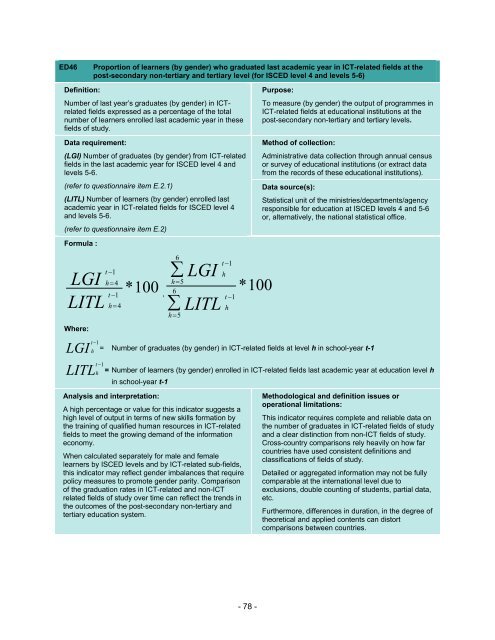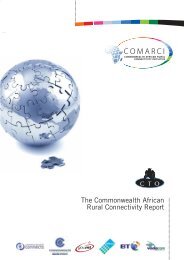Guide to measuring information and ... - unesdoc - Unesco
Guide to measuring information and ... - unesdoc - Unesco
Guide to measuring information and ... - unesdoc - Unesco
Create successful ePaper yourself
Turn your PDF publications into a flip-book with our unique Google optimized e-Paper software.
ED46 Proportion of learners (by gender) who graduated last academic year in ICT-related fields at the<br />
post-secondary non-tertiary <strong>and</strong> tertiary level (for ISCED level 4 <strong>and</strong> levels 5-6)<br />
Definition:<br />
Number of last year’s graduates (by gender) in ICTrelated<br />
fields expressed as a percentage of the <strong>to</strong>tal<br />
number of learners enrolled last academic year in these<br />
fields of study.<br />
Data requirement:<br />
(LGI) Number of graduates (by gender) from ICT-related<br />
fields in the last academic year for ISCED level 4 <strong>and</strong><br />
levels 5-6.<br />
(refer <strong>to</strong> questionnaire item E.2.1)<br />
(LITL) Number of learners (by gender) enrolled last<br />
academic year in ICT-related fields for ISCED level 4<br />
<strong>and</strong> levels 5-6.<br />
(refer <strong>to</strong> questionnaire item E.2)<br />
Formula :<br />
t 1<br />
LGI h<br />
4<br />
t 1<br />
h<br />
4<br />
LITL<br />
Where:<br />
LGI t1<br />
h<br />
* 100<br />
,<br />
6<br />
<br />
h<br />
5<br />
6<br />
<br />
h<br />
5<br />
LGI<br />
LITL<br />
t 1<br />
h<br />
t 1<br />
h<br />
* 100<br />
- 78 -<br />
Purpose:<br />
To measure (by gender) the output of programmes in<br />
ICT-related fields at educational institutions at the<br />
post-secondary non-tertiary <strong>and</strong> tertiary levels.<br />
Method of collection:<br />
Administrative data collection through annual census<br />
or survey of educational institutions (or extract data<br />
from the records of these educational institutions).<br />
Data source(s):<br />
Statistical unit of the ministries/departments/agency<br />
responsible for education at ISCED levels 4 <strong>and</strong> 5-6<br />
or, alternatively, the national statistical office.<br />
= Number of graduates (by gender) in ICT-related fields at level h in school-year t-1<br />
LITL t 1<br />
h = Number of learners (by gender) enrolled in ICT-related fields last academic year at education level h<br />
in school-year t-1<br />
Analysis <strong>and</strong> interpretation:<br />
A high percentage or value for this indica<strong>to</strong>r suggests a<br />
high level of output in terms of new skills formation by<br />
the training of qualified human resources in ICT-related<br />
fields <strong>to</strong> meet the growing dem<strong>and</strong> of the <strong>information</strong><br />
economy.<br />
When calculated separately for male <strong>and</strong> female<br />
learners by ISCED levels <strong>and</strong> by ICT-related sub-fields,<br />
this indica<strong>to</strong>r may reflect gender imbalances that require<br />
policy measures <strong>to</strong> promote gender parity. Comparison<br />
of the graduation rates in ICT-related <strong>and</strong> non-ICT<br />
related fields of study over time can reflect the trends in<br />
the outcomes of the post-secondary non-tertiary <strong>and</strong><br />
tertiary education system.<br />
Methodological <strong>and</strong> definition issues or<br />
operational limitations:<br />
This indica<strong>to</strong>r requires complete <strong>and</strong> reliable data on<br />
the number of graduates in ICT-related fields of study<br />
<strong>and</strong> a clear distinction from non-ICT fields of study.<br />
Cross-country comparisons rely heavily on how far<br />
countries have used consistent definitions <strong>and</strong><br />
classifications of fields of study.<br />
Detailed or aggregated <strong>information</strong> may not be fully<br />
comparable at the international level due <strong>to</strong><br />
exclusions, double counting of students, partial data,<br />
etc.<br />
Furthermore, differences in duration, in the degree of<br />
theoretical <strong>and</strong> applied contents can dis<strong>to</strong>rt<br />
comparisons between countries.
















